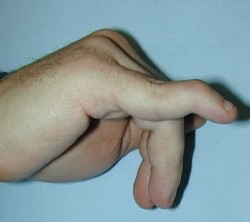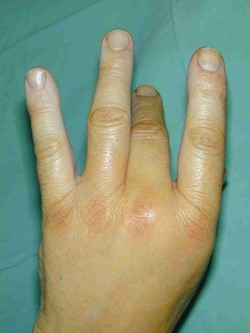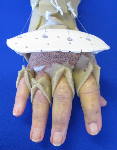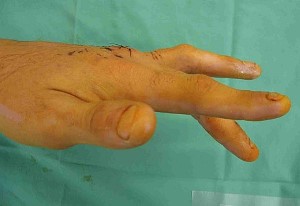
Anatomy:
Extensor tendons, located on the back of the hand, allow you to straighten your wrist, fingers and thumb.
These tendons are attached to muscles in the forearm. They are called the Extrinsic muscles.
The tendons are like rope attached to the muscle bellies in the forearm.
When the muscles contract they pull on the rope and movement is induced in the fingers.
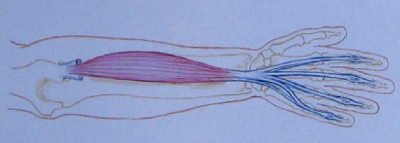
As the tendons continue into the fingers, they become flat and thin. In the fingers, these tendons are joined by smaller tendons from the muscles in the hand. These muscles are called Intrinsic muscles. It is these small muscle tendons that allow delicate finger motions and coordination.
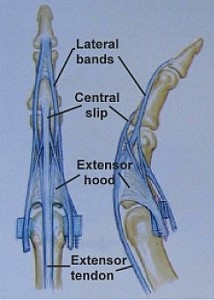
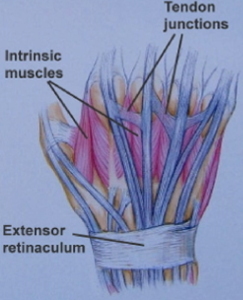
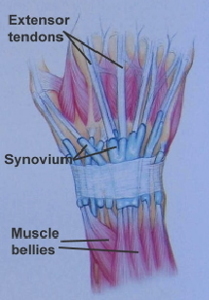
A strap of tissue (Extensor Retinaculum) passes across the pack of the wrist to hold the extensor tendons in place. A lubricating tissue ( Synovium) separates the tendons from the retinaculum. This can become inflamed and is then known as “Tenosynovitis”.
The Extensor Hood stabilises the tendons on the back of the knuckle. This can rupture with minor trauma ( See below) or stretch in some types of arthritis.
The various levels of the tendon are divided into Zones. This aids in planning treatment. Different zone injuries require different types of splints.
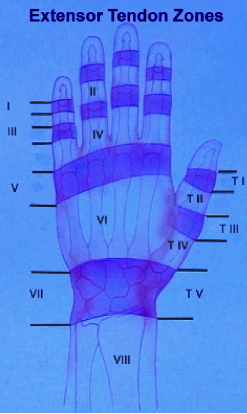
Mechanism of Injury:
The Extensor tendons are just under the skin and so are vulnerable to a wide variety of injuries. The tendons lie directly on the bone on the back of the hands and fingers.
- Lacerations from sharp objects or punching injuries
- End on injuries in sport eg Oz tag, Touch football may cause the tendons to pull apart from their attachment to bone. After this type of injury the finger deformity may not develop immediately.
- Trivial injuries eg making a bed and catching ones finger
Examples:
1. Mallet Finger (See separate Section)
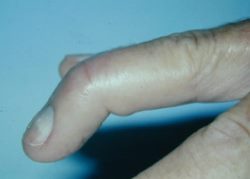
2. Boutonniere Deformity: ( See separate Section)
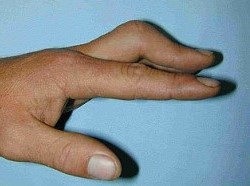
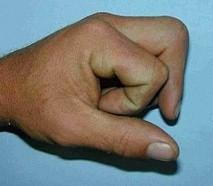
3. Swan Neck Deformity
This is an uncommon deformity but may occur after a Mallet finger injury or in Inflammatory arthritis.
The end joint of the finger droops and the second joint ( P.I.P. joint) hyper-extends.
4. Extensor Hood Rupture:
This often follows trivial trauma to the hand. It results in the finger catching in a slightly flexed position often deviating towards the little finger. It is treated with surgical repair of the hood.
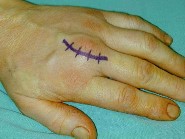
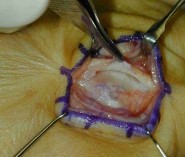
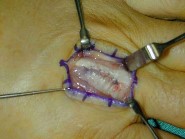
5. Lacerations:
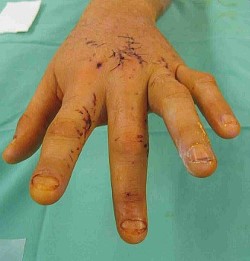
Depending on the site of laceration many different deformities may develop. Sometimes no deformity is seen initially after complete division of a tendon. Here a wound has been sutured in Casualty and the tendon laceration had been missed. These injuries should be explored and repaired in an operating theatre with repair of the tendon end with sutures. Post operative splinting is required.
Treatment:
1. Splints:
Most extensor tendon injuries are treated with a splint for 6 weeks and sometimes more. Splinting for a tendon injury in this area may include the wrist and part of the finger. Dynamic splinting, which is a splint with slings that allows some finger motion, may be used for injuries of this kind. The dynamic splint allows early movement and protects the healing tendon.



End on injuries with no cut can often be treated with splints. Splints stop the healing ends of the tendons from pulling apart and should be worn at all times to make sure the finger stays straight until the tendon has fully healed. Consult the Hand Therapist for more detail.
2. Surgery:
Lacerations that actually divide the tendon need sutures.
Sometimes a wire is placed through the bone across the joint as an internal splint while the wounds heal
3. Hand Therapy Therapists can make splints and supervise your rehabilitation
Problems:
Extensor tendon injuries can cause:
- Finger deformity due to muscle imbalance
- Tendon adhesions: The tendon can attach itself to nearby bone and scar tissue.
- Finger stiffness - scar tissue that forms may prevent full finger bending and straightening even with the best
treatment Surgery to free scar tissue can sometimes be helpful in serious cases of
motion loss.
Results:
Many things can affect the outcome after extensor tendon injury.
- Associated fractures
- Delay in treatment
- Compliance with treatment and splintage
- Infection
- Patient variability with respect to density of scar formation.
See the other sections of the website for more information on specific types of extensor tendon injuries.
LAST UPDATED ON 28 / 2 / 15

